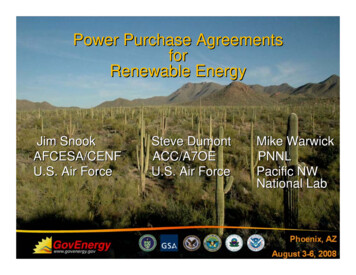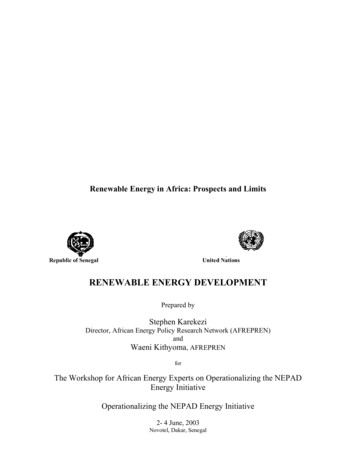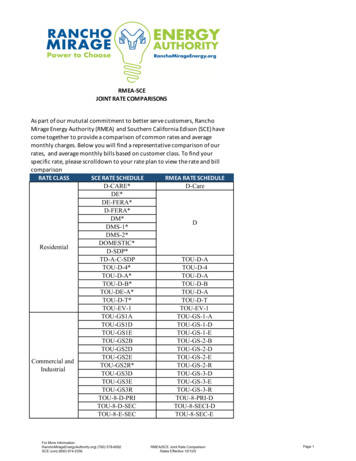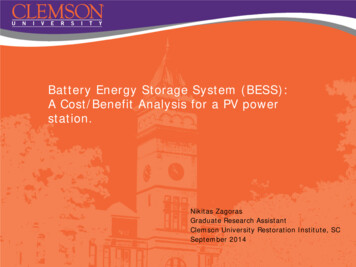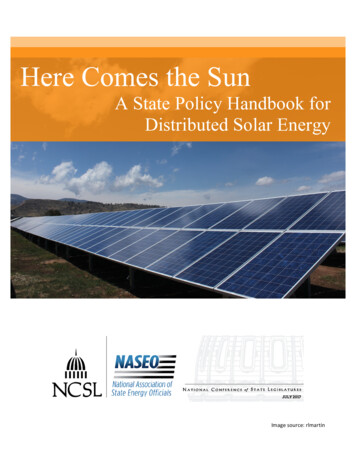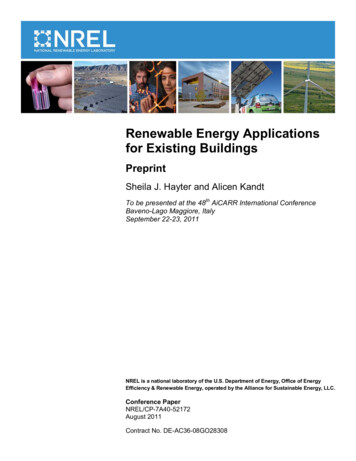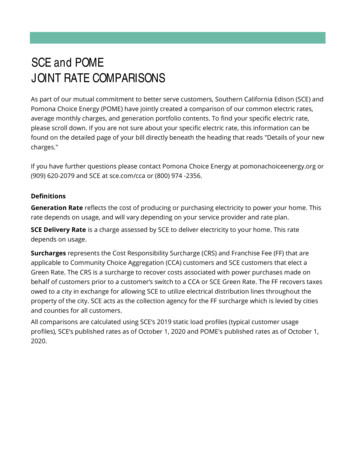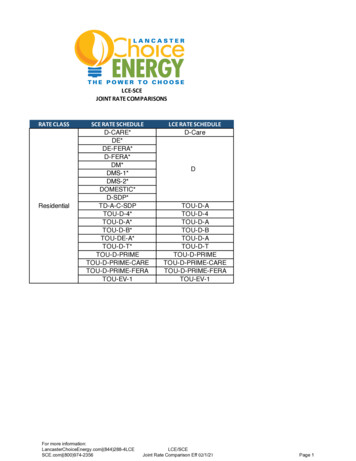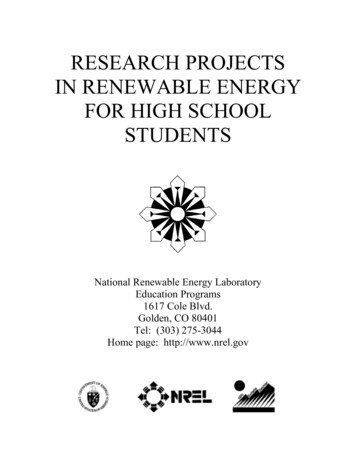
Transcription
RESEARCH PROJECTSIN RENEWABLE ENERGYFOR HIGH SCHOOLSTUDENTSNational Renewable Energy LaboratoryEducation Programs1617 Cole Blvd.Golden, CO 80401Tel: (303) 275-3044Home page: http://www.nrel.gov
ACKNOWLEDGMENTSThe Education Office at NREL would like to thank Dr. James Schreck, Professor of Chemistry andBiochemistry, University of Northern Colorado, for his commitment and hard work in the development ofthis activity booklet. His expertise was invaluable in producing a final product that attempts to be "userfriendly."It is the goal of the Education Office to make these kits accessible, easy to use, and fun. We want yourstudents to gain, not only an understanding of renewable and nonrenewable energy resources, but agreater confidence in investigating, questioning, and experimenting with scientific ideas.If you have questions, please call the Education Office at (303) 275-3044 or e-mail:linda lung@nrel.gov
HOW TO USE THIS BOOKLETThe purpose of this booklet is to provide high school students with a variety of projects to broaden theirknowledge of science, in particular renewable energy, and the scientific method. Projects are available inthese areas of renewable energy: biofuels, wind, and solar.Science projects described here apply the disciplines of chemistry, physics, biology, and mathematics.Below are some suggestions for effective use of this booklet:1. First, check your EQ (energy quotient). Let your teachers grade the test you take and then decide if youneed to improve your energy background. The Education Office at the National Renewable EnergyLaboratory (NREL) has a small library you can use to improve your background. It is also useful forobtaining background material on an energy project described in this booklet. Contact the Education Officeat NREL in Golden, Colorado at 303-275-3080 to set a time to visit the facility. It is not advisable to visitthe facility without prior contact since NREL is a government facility, and your visit must be approved.Don't let that keep you away, however; the Education Office staff is happy to help you if they can.2. Read the section on "How to do a Science Project."3. Decide if you want to do a technical report or a hands-on activity research project in the area of biofuels,wind energy, or solar energy.4. Choose a project, and discuss it with your teachers. You will likely need an area in your laboratory for aperiod of time. Your teacher will help you with the availability of equipment and materials.5. Use the Idea for Study to decide on a project. In many cases, suggestions are made for the study. Don'tattempt every possible angle (variable); don't try to answer every question. Discuss your progress on aroutine basis with your teachers. Often those not directly involved with the project have insight andsuggestions that are worthwhile considering.6. Keep in mind that the length of time spent on the project is not indicative of the quality of the work. Aresearch project always provides the answer to the original question and raises one or two more questionsfor future study.7. Keep a research notebook, and write in your notebook on a routine basis. When you complete yourproject, the notebook entries can be used to write the report.8. Be sure to communicate your results with others through the research report and/or a poster display.GOOD LUCK!
WHAT' S YOUR ENERGY QUOTIENT?Pretest on Energy PrinciplesI. Check those statements that describe energy:leaves moving in the winda pot of boiling waterdriving a car to schoolfinding your way in the dark with a flashlightburning gas in a furnacegrilling a steak2. What does the phrase "I don't have much energy today" mean to you?3. What do you think the phrase "energy source" means?4. Make a list of as many energy sources as you can think of.5. Energy sources can be placed in two categories: renewable and nonrenewable. How do you thinkthese two energy sources differ from each other?6. Look at your list of energy sources in question 4, and label them as renewable or nonrenewable.7. In contrast to nonrenewable, renewable energy sources produce little or no pollution or hazardouswastes, pose few risks to public safety, and are entirely domestic resources. Explain why you agree ordisagree with this statement.8. Energy sources are used mainly to produce electricity--a more useful energy source. Choose any energysource you listed in question 4, and describe how this is accomplished.9. Why is it important not to waste energy? As a citizen, how to you conserve energy?10. Assume all the reserves of nonrenewable energy sources have been depleted. How do you think peoplewill light and heat buildings, and what will they use for transportation?
HOW TO DO A SCIENCE PROJECTThe scientific method is a pattern of inquiry thatforms a structure for advancing scientificunderstanding. By identifying a problem,forming a hypothesis, designing and conducting an experiment, taking data, and ana1yzing the results, scientists have answeredquestions ranging from the simplest to the mostcomplex. Yet the process can be broken downinto several distinct steps.We've tried to be quite explicit in outlining thesteps of the process. And we believe doing allthe steps is appropriate for the student doing anindividual project-either as a classroom projector for a competitive fair. On the other hand,teachers doing projects in the classroom mightchoose to skip some of the steps, depending onthe level of the students and the time available.1. Identify an area of interest Decide what area ofscience is of intereste.g., physics,biology, chemistry,or engineering. Narrow the area ofinterest so that it ismore specific, e.g.,solar energy, plants,or anima1s.2.Gather informationOur knowledge of the world results fromideas and observations made by us and byothers. Many of these observations arerecorded in such scientific literature asscientific journals, government documents,periodicals, and books. Search for information in the area ofinterest in the library. Begin in an organized manner by usingreference material such as the Reader'sGuide or the card catalog. Keepin mind that most Scientificjournals publish information pertainingto a single field of Science. For example,the American Journal of Physics and theAmerican Journal of Botany relate tospecific topics. On theotherhand,someperiodicals, such asScientific American andScience, cover a rangeof scientific issues. Make sure to record theauthor(s), titles of thearticle and the journal, tilepage numbers, and pertinent publishinginformation for every reference used.(Recording this information on note cardsis helpful.)3. Select a specific problem within the areaof interestIt is important to narrow the research area toa specific problem. One common error is totry to do too much. (This process would berepeated as more information is gathered.)4. Gather more informationIt may be necessary to return to the libraryand look for information that deals directlywith the specific topic. Look for ideas thatmay help in the experimental design or forideas that complement the topic.5. Plan an investigation or an experimentKeep these things in mind when designingthe experiment: Are tile variables appropriate? Are tile variables independent? Are the variables measurable? What kind of controls will be included? What data will be collected? Is the experiment designed appropriatelyif the results are to be analyzedstatistically? Are the materials and equipment available? Are there some special safety or environmental concerns?
If the project uses mathematical or computermodeling instead of experimentation, how willthe results be validated? Is therea way to test the model?When the approach tothe experiment is clearit's time to write aproposal. The proposalshould describe theexperiment in detail,includingrequiredmaterials andequipment, any safety concerns, and expectedresults. It will allow the teacher or the sciencefair review committee to evaluate theappropriateness of the project.Include the following in the proposal: Background information: A review of theliterature summarizing information relatedto the project. Be sure to cite all references. Purpose and hypothesis: A brief descriptionof the purpose of the project and a statementof the hypothesis. Experimental design: A detailed explainton of the research plan and the materialsneeded is included in this section.The methods and materials should bedescribed in a way that anyone couldduplicate the experiment(s). Literature cited and references: Include alist of all authors cited and a list ofsupplemental references.6. Obtain approvalof the proposalfrom the teacheror science fairreview committee7. Conduct theexperiment(s)and collect data Record the data in a notebook. Recordthe data immediately, completely, andaccurately. (It is better to record toomuch data than not enough.) Record other observations about the experiment .ina notebook. e.g., describe\ progress, take pictures,make sketches. Are some things not goingaccording to plan? Are there any surprises? Theseobservations may be important later.8. Organize and report the resultsMost data involve numbers and can bequantified. Therefore, using statistics.graphs, tables, and charts areappropriate. Remember, this is theportion of the research on whichconclusions are based. The better thisportion is presented, the easier it is toformulate conclusions. Data shouldbe presented: in written form with graphs, tables, and charts without conclusions or value judgments9. Analyze and discuss the resultsThink about the results. What do they mean? Howshould they be interpreted? By discussing variousaspects of the experimentand observations, provideadditional context for theresults shown by thedata. Look for patterns,relationships andcorrelations.10. Formulate conclusionsWas the hypothesis supported? This is an importantstep and must emphasize what has been learned fromdoing the project. Conclusion statements must besupported by data collected and related directly to thepurpose and hypothesis.11. Assess the projectDid the expe1iment go as planned? If so, were thereother interesting aspects that deserve follow-up
research? If theexperiment didnotgoasplanned,whynot? Was thehypothesis toobroad? Was theexperimental,design inappropriate?If the hypothesis was not confirmed,what was learned? Answers to all thesequestionscanhelpformrecommendations for further research.12. Write the final reportThe final report, whether it is to be presented orally or in written form, shouldinclude the following: Title- should be se1f-explanatory, i.e. thereader should be able to tell what theresearch is about without reading thepaper. Abstract- a brief condensation of the entirereport, 150 to 250 words for advancedstudents; shorter for students in lowergrade levels.- includes the purpose, very brief explanation of methods, and conclusions. Introduction- contains background informationwith cited references, statement of theproblem or purpose. Methods and Materials- contains an explanation of how thework was done (experimental design)- describes materials -what? -howused?- is stated briefly and clearly so thatothers could repeat the experiments. Results- includes a written explanation of thedata in a straight forward mannerwith no conclusions or judgmentstatements- uses tables. graphs. pictures. and othertypes of data where appropr1ate Discussion- explains what the results mean- describes patterns, relationships,and correlations. .Conclusions- presents the important conclusionsthat the reader needs to know- includes a discussion of problemsencountered and recommendations forfurther research. Literature Cited- lists alphabetically by author all publishedinformation referred to in thetext of the paper. Other referencescan be used and referred to in abibliography .(See examples in theResources section of this book for properform.) Acknowledgments- lists and gives credit to people whowere helpful in providing materia1sand equipment or ideas.13. Present the results orallyIf this is a project forthe classroom, makean oral presentationabout the work to theclass. If the project isfor a science fair,.prepare a display (seescience fair officialsfor details) and prepareto discuss the projectwith the judges. Ineither case, be prepared to: be knowledgeable about the project practice the presentation before others talk clearly act interested dress neatly .
TECHNICAL REPORTPreparing a science report that does not involve hands-on activities is a very important andworthwhile endeavor. Some students enjoy science, but don't find laboratory activities fun andexciting. Similarly, other students enjoy hands-on activities, but don't enjoy the task of writing abouttheir results. However, both tasks (doing science and writing about science) are important to bothscientists and citizens, and neither is more useful than the other. It is a matter of personal choice.The research report suggested here is for students who would prefer to write a technical, scientificreport. However, this project involves more than just writing. As such it involves the following tasks: topic research report preparation photography art technical displayIt could easily be a group project that would culminate in a written report and poster display. Thetask is to prepare a report based on the concept map in Appendix 1. This energy concept mapcategorizes some of the important aspects of energy .The task is to research and describe thefollowing facets of each category .The suggested questions in each category below are designed tohelp you with ideas that are important in a discussion of the category, and should be incorporated inyour report. WHAT IS ENERGY? Define and describe energy. Distinguish between potential and kineticenergy and give examples of each. What is the Law of Conservation of Energy .Why is itsignificant to know that when energy is transformed it is conserved in quantity but not inquality? What is the primary energy transformation for most energy resources? What effect doesusing energy have on citizens' lives? What is energy conservation and why should citizensconserve energy? In what way(s) does energy use impact the environment? ENERGY FLOW. How does the flow of energy from the sun affect wind and water cycles?How does sunlight help plants trap energy? How does the energy in plants get passed alongthrough the food chain? How do humans utilize this energy? HISTORIC RESOURCES. Describe the manner in which these resources are used for energy?Define renewable and nonrenewable energy resources and categorize each of the ones listedhere as renewable and nonrenewable. How much is used each day and for what purpose? Are allthese resources available in your state? How much? What are the pros and cons of each as anenergy resource? ENERGY ALTERNATIVES. Describe each of these and give pros and cons about each.Which are renewable and nonrenewable? Are all alternatives available in your state? Whatenvironmental impact would these energy resources have?Ideas to Study1. Prepare a poster display. You will need to write a brief overview (called an abstract) of your reportby section. You might work with a group and have someone take or obtain 3-4 photographs relatingto ideas of each section (for example, you could illustrate potential versus kinetic energy by having aphotograph of your team ' s quarterback before the ball is snapped, and then another as the ball isreleased for a pass) .You might work with a friend from the school newspaper or yearbook staffinterested in page layout and technical display.
2. Prepare a shorter version of your report to be published in the school newspaper.3. Give an oral presentation (with slides or overhead transparencies) to a science class in yourschool.or to a middle school classroom that you have permission to visit.Doing science in this manner can be satisfying and rewarding. Technical reports are numerous onTV and in the newsprint. Maybe someday you will have written the paragraph read by yourfavorite TV newsperson or reported in Time and Newsweek magazines on the yet to be discoveredfourth state of matter.
BIOFUELSProject #1: What is the efficiency ofethanol production from various sources?Project #2: What kind of biomass is bestfor producing methane gas?Project #3: What kinds of plants have themost heat energy in a given quantity ofbiomass?Project #4: How much energy can beobtained from alcohol fuels?Project #5: What factors affect biomassgrowth?
BIOFUELSBiofuels are produced from biomass. Biomass includes living organisms such as plants, trees andcrops, as well as half of all trash. The major potential of biomass is for production of liquidtransportation fuels. These fuels include ethanol and methanol, two alcohol fuels made from corn,wheat and other crops, and methane, a colorless, odorless and flammable gas made from waste.Ethanol, methanol and methane offer an attractive alternative to petroleum-based gasoline anddiesel fuels.There are more than 185 million vehicles in the U.S., and these vehicles are responsible for twothirds of the nation's total oil consumption. The quantity of biomass currently available couldproduce enough liquid transportation fuel to replace all the gasoline we currently use in thesevehicles. By the end of the decade, technological advancements will make these fuels as affordableand easy to use as today's petroleum-based gasoline and diesel fuels.PROJECT #1 WHAT IS THE EFFICIENCY OF ETHANOL PRODUCTION FROMVARIOUS SOURCES?Reference A procedure for preparing ethanol is given in many organic chemistry laboratorymanuals. For example, see Pavia et al. Introduction to Organic Laboratory Techniques, SaundersCollege Publishing, 3rd ed., 1988 "Ethanol from Sucrose," p.84.Ideas for Study1. Compare the relative yields of ethanol produced from various sources: table sugar, grain crops,fruits, cellulose, corncobs, corn silage, etc. One way to do this is to use rate or total volume ofcarbon dioxide production as an indirect indicator of ethanol production. For a more accuratemeasurement, contact the chemistry department at a college/university to see if someone would letyou use a gas chromatography unit. Demonstrate the energy of the distillate fuel by soaking it incotton wool and setting it alight. Don't forget to run a control.
2. Develop a procedure for determining the percentage of alcohol you can prepare from the varioussources. One method might be to use potassium dichromate standards. This substance is the basis forsome commercial kits for determining alcohol levels before and after consuming alcoholic beverages.3. Investigate optimum temperature for fermentation.4. Investigate aerobic and anaerobic conditions for producing ethanol.5. Investigate methods of quantifying ethanol production from one or more sources.PROJECT #2 WHAT KIND OF BIOMASS IS BEST FOR PRODUCING METHANE GAS?Caution Methane gas is explosive when mixed with air! Extreme care must be taken when generatinglarge quantities of methane. Don't attempt this project in a laboratory or home basement if flames froma laboratory burner or furnace are around. Be sure to purge the system of air before attempting to burnmethane!Materials Source of biomass (e.g. animal dung. garbage, food wastes, etc.).Equipment Methane generator as shown below.Resources (I) Williams, D.I. and D. Anglesea, 1978, Experiments on Air Pollution, Hove, England:Wayland Publishers Limited, p. 50-51. (2) "Larry J. Romeesberg Cooks with Bio-gas." December1975, from Adventures in Alternative Energy, Popular Science.Ideas to Study1. Compare the volume of methane gas produced from equal amounts of biomass. Fill the jar withbiomass and make sure it is well pressed down to remove as much air as possible. Biomass must bemoist (add water if necessary). Be sure that the delivery tube is above the biomass in the generator. Thebest incubation temperature is 36-37 C.2. Investigate the effects of temperature on methane generation. CAUTI0N: do not use a laboratoryburner of any type to raise the temperature of the contents in the jar .To raise of lower the temperature,
place a pan of hot or ice cold water beneath the gas generator. You made need to devise a safe wayto keep the temperature warmer or colder than the optimum temperature.PROJECT #3 WHAT KINDS OF PLANTS HAVE THE MOST HEAT ENERGY IN AGIVEN QUANTITY OF BIOMASS?Equipment Laboratory balance and a calorimeter (see diagram below):Safety Work in a well-ventilated area. Be extremely careful of burns because a lot of heat energywill be generated.Reference A college level general chemistry text will have a chapter on thermochemisty that will beuseful in seeing some of the calculations needed to do in this project.Ideas for Study1. Conduct preliminary tests to determine the best size of plant material to test. Compare the heatenergy in a given quantity of plant materials (e.g., peanuts, pecans, walnuts, castor beans,sunflowers, corn, and milkweed). Calculate he amount of calories per gram. Use equal volumes ofwater in the test tube for each test and record the beginning and ending temperatures.2. You can improve your results by using a bomb calorimeter. Check with the chemistry departmentat a college or university.3. Determine the usable heat energy that could be produced on an acre of land if certain crops wereraised. Choose peanuts and sunflowers, for example. This would require one to know the caloricvalue (cal/g) and the amount of biomass produced per unit area.4. Devise a procedure for extracting the oil from the plant and determine the oil's heat energy. Forexample, milkweed contains latex, an unsaturated hydrocarbon.
PROJECT #4 HOW MUCH ENERGY CAN BE OBTAINED FROM ALCOHOL FUELS?Materials Use the set up for the calorimeter as described in Project #3, but use an alcohol burner as thesource of heat.Caution Alcohols are very flammable. Work in the science laboratory under supervision of your teacheror another adult.Ideas for Study1. Compare the heat energy from burning alcohols (e.g., methanol, ethanol, propanol, rubbing alcohol,etc). Measure the weight of alcohol before and after the burning alcohol raises the temperature of 100 mL(equals 100 g) of water at least SOOC. Calculate the calories per gram for each alcohol tested.2. Devise a more efficient procedure that reduces heat loss. Determination of heat values and efficienciesas related to cost would be important to know. How could these fuels be used?PROJECT #5 WHAT FACTORS AFFECT BIOMASS GROWTH?Caution Handle fertilizers, pesticides, and plant hormones with care.Procedure Grow plants from seeds in cups or pots. Measure height and width daily or measure dryweight after several days or weeks. Use a variety of plant types -food and nonfood, grasses, and weeds.Weigh soil to see how much "earth" is used.Ideas to Study1. Investigate plant growth utilizing one of these factors. Keep in mind each factor can be a study initself:a. Type of light.b. Amount of light.c. Spacing of seedlings.d. Soil type.e. Frequency of watering.f. Fertilizer vs. no fertilizer.g. Pesticide vs. no pesticide.h. Salt content of water [use varying concentrations of salt water and measure dry weight afterdays or weeks].i. Plant hormone vs. no plant hormone. [Apply plant hormone with aspirator or a perfume bottleor small paint brush, but apply evenly. Biomass can be determined as fresh weight and dryweight (dry in oven) for 24 hrs at 90"C -include roots.]
j. Orientation of a single seed when planted. [Replicate the orientation of seeds planted severaltimes. Remember the greater the sample size the more reliable the data. Plant each seed at thesame depth as the others. Make sure that the light source is equally distributed on each traycontaining the seeds.]k. Depth seed is planted in soil.l. Effect of increased amount of carbon dioxide (see diagram below and handle dry ice withcare). [plants should have a minimum of 5-6 leaves and be of approximately equal size.Calculate total leaf at the beginning and end of the experiment for each plant. If dry ice is used,consider that carbon dioxide is heavier than air and also consider the temperature effect onplants. Use same soil provide equal amounts of water and light. Could use sodium bicarbonateand monitor pH.]m. Effect of temperature on the rate of photosynthesis [Assemble the apparatus as shown in thediagram below and take care assembling the apparatus, specifically the insertion of a glass tubeinto a rubber stopper. Be careful of the hypodermic syringe. Many general biology lab manualsgive directions for measuring gas production in photosynthesis. Don't forget to set up a control(minus the plant). Keep light intensity the same and remember that most light sources produceheat.
WIND ENERGYProject #1: What techniques can be used tomeasure and compare wind direction andspeed?Project #2: How does a wind propelleraffect how much electricity it produces?Project #3: What is the most efficientspacing of wind turbines for “farming” windin a given unit of space?
WIND ENERGYThe Earth's winds contain vast amounts of energy. People have harnessed this energy for thousandsof years to sail ships, grind grain and pump water. Today, advanced wind turbines offer an efficientmeans of capturing wind energy and using it to produce electricity. Wind turbines are used forindividual homes and also grouped together in wind farms to generate electricity for utility grids.Wind turbines have two or three long, light-weight blades that turn quickly. The longer the bladeand the greater the wind speed, the more electricity generated. Steady wind speeds of no less than12 miles per hour year round are required to effectively generate electricity.CAUTION: Take precautions when working with fans and electricity.PROJECT #1 WHAT TECHNIQUES CAN BE USED TO MEASURE AND COMPAREWIND DIRECTION AND SPEED?Materials Beaufort Wind Scale (see Appendix 1), wind vane, and anemometer. Calibrate vane witha compass and calibrate the anemometer through the window of a car.Resource Bulletin of the American Meteorological Society, May 1989.Vol. 70, No.5, p.490-508.Ideas to Study1. Compare the Beaufort Wind Scale to the wind vane and anemometer for measuring winddirection and speed at a specific site for a determined time period (e.g., morning, noon, andafternoon or evening for a six week period of time). At what time of day do the fastest winds usuallyoccur? Which method is more reliable and why?2. Compare the design of the wind vane and/or anemometer for efficiency at a specific site over aperiod of time.3. Compare different sites for collecting wind energy using the wind vane and/or anemometer for agiven period of time.4. Determine how the topography affects the results in one of the studies above.5. Determine how the height of the device (wind vane or anemometer) affects the results in one ofthe studies?6. Make a map of measured wind versus location, time of year, and time of day.PROJECT #2 HOW DOES A WIND PROPELLER AFFECT HOW MUCH ELECTRICITYIT PRODUCES?Materials Fan (2-3 speeds) or hair blower, a 1.5 v dc motor, voltmeter (0-5 v), a 100-ohm resistor,and insulated wire that is typically available from your Physics instructor. Propellers (modelairplane from a hobby shop or see Appendix 2 for building three different wind propellers) .Youshould also design and build your own wind propeller. See sketch for experimental set up. Youmight want to do your study in a wind tunnel, which you can make from cardboard.
Ideas to Study1. Compare the blade angles and how the propeller spins. Attach Model 1 to the motor shaft. Tiltthe blades so that they are perpendicular to the end of the cork (Figure A). Place the windmachine in front of a working fan (or a hair blower). If the propeller doesn't spin, slightly rotatethe blades so that they are at a small slant (Figure B). Place the propeller in front of the fan orhair blower. Keep tilting the blades in small increments until the propeller starts spinning. Whenthis happens, measure the voltage produced. Keep titling the blades of the propeller to see whichangle produces the greatest voltage. Deduce if the speed of the blades varies with the anglebetween wind direction and blade. How might the material from which the blade is made (paper,stock paper, plastic, etc.) affect the propeller spin? How might the number of blades (1,2,3,etc.)affect the spin of the propeller?2. Compare the size of the wind blades with how fast a propeller can turn. Keep the wind bladeon Model 1 at the angle at which they produced the greatest voltage. Measure the voltage. Then,attach Model 2 wind propeller to the motor shaft, with the blades at the same angle. Put it in frontof the fan or hair blower at the same distance as you did with the first propeller (Why?). Measurethe voltage by this wind turbine. Repeat for the other models. Determine if the amount of energyderived from the wind varies with the area swept by the blades or the size of the blades (diameterof the wheel).
3. Compare the shape of the propeller blades and how fast they can spin. Keep the wind bladeson Models 1 and 2 at the same angle as in the previous study. Measure the voltage again. Thenattach Model 3 wind propeller to the motor shaft, with the blades at the same angle as the Models1 and 2 wind propellers? Measure the voltage. Repeat with the wind propeller you designed, andmeasure the voltage. Deduce if the shape of the blades in a wind propeller determine theefficiency of conversion.4. Compare how wind speed affects the electricity output of wind machines. Use any of thepropellers, and place the wind machine in front of a two-speed fan. Turn fan on low speed.Measure voltage. Then turn fan of high speed and repeat measurement. Determine if there is amathematical relationship between the energy derived from the wind and the wind speed. Deducehow concentrating the wind speed through a cone affects the electr
teachers doing projects in the classroom might choose to skip some of the steps, depending on the level of the students and the time available. 1. Identify an area of interest Decide what area of science is of interest e.g., physics, biology, chemistry, or engineering. Narrow the area
